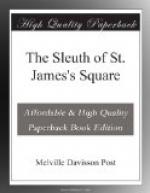“But we see it spread, Miss Warfield,” said the trackman with a conclusive gesture.
“True,” replied Marion, “we see that it did spread, under this condition, but why?”
The old woman sitting beside the track seemed to realize what was under way; for she rose and came over to where I stood. “Contessa,” she whispered, in those quaint, old world words, “do not reveal, what I have tol’. I pray you!”
And she followed me across the few steps to where the others stood.
I did not answer. I stood like one in some Hellenic drama, between two tragic figures. The love of woman lay in the solution of this problem — in the beginning and at the end of life.
Marion and the big track boss continued with this woman looking on.
I feared to speak or move; the thing was like a sort of trap, set with ghastly cunning, by some evil Fate. The ruin of a woman it would have. And perhaps on the vast level plain where it evilly dwelt, through its hard all-seeing eyes, the ruin and the sorrow either way would be precisely equal. How could I, then, lay a finger on the scale.
“Now,” said Marion, “when the engine reached this point on the track, one of the rails gave way first.”
The big workman looked steadily at her.
“How do you know that, Miss Warfield?” he said.
“Because,” replied Marion, “the marks of the wheels of the locomotive on the ties are found, in the beginning, only on one side of the track, showing that the rail on that side gave way, when the engine struck it, and the other rail for some distance bore the weight of the train.”
She illustrated with her hands.
“When the one rail was pushed out, the wheels on that side went down and continued on the ties, while the wheels on the other side went ahead on the firm rail.”
The workman saw it.
“That’s true, Miss Warfield,” he said, “one rail sometimes spreads and the other holds solid.”
Marion was absorbed in the problem.
“But why should the one rail give way like this and its companion hold?”
“One of the rails might not be as solid as the other,” said the man.
“But it should have been nearly as solid,” replied Marion. “This piece of track, you tell me, was examined to-day; the ties are equally sound on both sides, the rail is the same weight. We have the right to conclude then that each of these rails was about in the same condition. I do not say precisely in the same condition. Now, it is true that under these conditions one of the rails might have been pushed out of alignment before the other. We can grant a certain factor of difference, a certain reasonable factor of difference. But not a great factor of difference. We have a right to conclude that one rail would give way before the other. But not that one would very readily give way before the other. For some reason this particular rail did give way, much more readily than it ought to have done.”




